SEO
A Step-by-Step Strategy (Based on Updating 50+ Posts)

Content refreshing is one of the best ways to increase traffic of your existing content, and it’s also a great way to keep the information on your website fresh and up to date.
However, the content refreshing process isn’t always straightforward. For example, some people worry about tanking their organic traffic if they update the content (a valid concern). Other people find that it just doesn’t bring the dramatic traffic increase that some marketing experts promise.
Fortunately for you, I’ve been both of those people.
I’ve updated probably more than 50 blog posts in the past 12 months, and I’ve made a lot of mistakes. However, I’ve also seen outstanding results, such as content that drives 10 times more traffic and soars in rankings.
That said, I really wanted to know why some posts perform dramatically better post-update than others.
So I did a data study on what makes some content dramatically more successful post-update and why others continue to flounder. Using this data, I’ve come up with a content refreshing strategy that has significantly improved my content refreshing success rate. Today, I want to share that strategy with you.
Contrary to popular belief, not all blog posts are worth updating. This is one of the single most impactful realizations that has improved my content refreshing success rate. In fact, I only recommend prioritizing updates for old content that earned 20+ monthly visitors at peak performance.
In the data study mentioned above, 45% of the updated posts had fewer than 20 visitors per month pre-update. Unfortunately, this 45% of updated posts only contributed 15% of the total traffic increase (of a 96% total organic traffic increase).
That means blog posts that already had 20+ monthly visitors before the update contributed the majority of the total organic traffic increase.
My guess is posts with more traffic pre-update already rank for some keywords in positions #5–10. Therefore, it’s much easier to go from positions #5–10 to first than zero to first.
So what should you do with blog posts that have fewer than 20 monthly visitors?
Assuming these posts are targeting keywords that are valuable to your business or contain important thought leadership ideas, it’s definitely worth updating them. In addition, a smaller blog will generally have a lot more blog posts with fewer than 20 monthly visitors simply because it needs time to gain traction.
Therefore, it’s still worthwhile to update them, but prioritize posts with the most potential first.
Once you know which posts to update, how do you actually update them? I’ve found that a lot of companies give freelance writers a process that looks like this:
- Update old statistics, facts, quotes
- Add additional paragraphs for keywords the posts are missing
- Remove sections that are no longer relevant
However, I’ve found that the above strategy isn’t the best approach to refreshing content. It makes the content more up to date but doesn’t consider how the post is (or is not) fulfilling the search intent.
In other words, you have to ask why your content isn’t as useful as the posts ranking well on Google. (I’m willing to bet it’s not just because there’s an outdated statistic in the third paragraph.)
From the content refreshing research I’ve done, your post probably isn’t ranking because there is another post that:
- Is more current.
- Provides actionable advice (or more relevant details).
- Offers an excellent user experience.
- Is a better fit for the searcher’s intent.
To address these issues, here are the action steps you need to take while updating your content.
1. Update outdated information
I know I just said that refreshing content is much more than just updating outdated information—but it is a part of the process.
In addition, I’m talking about more than just updating old statistics and quotes. Often, you’ll have to update (or completely change) the examples to improve how they match the search intent.
For example, this is one of my most successful content refreshing examples ever. It was generating about 4,000 monthly visitors when I first updated it in 2019. At its peak performance, it generated about 20,000 monthly visitors.
When I started updating it, I realized that most of the examples in the post were outdated and many were TV productions. This was a problem for two reasons:
- TV commercials themselves aren’t really a great fit for someone searching “digital marketing campaigns.”
- Most of the people Googling this term don’t have the budget for a TV campaign.
Therefore, I replaced all 31 examples with 31 new examples of recent SEO, content marketing, YouTube, and podcasting successes.

Sidenote.
In retrospect, I wish I had focused on a specific campaign rather than the brand’s entire strategy. This is as the searcher’s intent is a digital marketing campaign, not a digital marketing strategy. I bet the post would have performed even better if I had done that. But we’ll get into searcher intent a little later.
Key Takeaway
Is the information you provide up to date with the current trends in your industry? This includes not only quotes and statistics but also examples that you use.
2. Add actionable advice/cut irrelevant detail
How often have you read a post that vaguely describes what you should do and lacks examples or the action steps needed to execute the advice?
On the other hand, have you ever read a post that has the answer to your question somewhere in it? But then there is so much unnecessary information that you can’t find what you want.
Both are equally problematic and, unfortunately, common in content marketing.
First, let’s discuss posts that lack depth. Unfortunately, there is no specific metric you can check to see if the content has depth. Though, there are a few signals that can clue you in, including:
- Few to zero examples.
- A significantly shorter word count than what’s ranking.
- Generic tips with no actionable information.
You can also use content optimization tools like Clearscope, which shows the subheadings that commonly appear in other top-ranking posts. While I recommend that you take these keyword tools with a grain of salt (don’t try to sprinkle in all of the keywords), they can help you uncover topics you may have overlooked.
For example, if you’re writing a guide to “medical SEO,” the tool may show that the word “backlinking” is commonly used in other posts. Given that backlinking is a key element of SEO, this is a helpful insight because you’ll definitely want to create a section on that topic.
Beyond this, the best advice I can give you is to put yourself in your target audience’s shoes (ideally, you’ve already done extensive market research and talked to several customers).
Ask yourself: If they read this content, could they implement the advice given and see results?
To drive this home, let’s look at an example where the post lacked depth. This post, “13 Ways to Market Your Business Online,” is the very first post I ever updated. It was originally just 930 words long and drove between 30 and 50 monthly visits. The final product is 1,700 words. It now drives over 600 monthly visits.

However, I didn’t just decide to make it longer to accomplish this. Instead, I added relevant, actionable advice to support my argument.
For example, in the excerpt below, you can see that I supported my argument (building a brand is important) with a quote from Google CEO Eric Schmidt. I also added an actionable tip to make the tip less vague.

Everything highlighted was added or changed when updating the post.
That said, adding more depth isn’t always the best solution, as it can make content unnecessarily long-winded.
For example, let’s say you’re writing a post on “how to change a tire.” In this case, the reader really doesn’t want a 2,000-word guide—they just want to change their tire as quickly as possible!
So instead of writing about the mechanics of changing a tire and statistics on how many people know how to change tires, just give the reader the steps they need to change the tire.
While that may be a rather obvious case, I see this all the time when I update content (especially if it’s an ultimate guide). For example, here’s the table of contents of a post I’m preparing to update:

As you can see, the content is too long and repetitive. For one, it talks about the ROI of influencer marketing twice. Sure, it’s an ultimate guide. But even those reading an ultimate guide only want to consume the necessities to get them on their way.
Another example of how this content is too long-winded is in chapters 2 and 7, where both discuss tactics on reaching out to an influencer. Sure, they discuss slightly different tactics. But I’d rather read one concise section on the 80/20 of influencer outreach than several sections containing every possible way you could reach out to an influencer.
Key Takeaway
When you’re writing, include the 80/20 action steps your reader needs to know, along with examples (hypothetical or real) to prove your point. However, don’t write any more than that. The reader doesn’t necessarily need to know every single possible way to do something or the exact science behind every topic. Get to the point.
3. Improve the user experience
Google has always stressed the importance of optimizing for user experience. Much of this takes place at the site level (HTTPS, page speed, etc.). But there are things you can do to improve content on a post-by-post basis.
First, if your post is particularly long, consider adding a sticky table of contents to help the reader find exactly what they are looking for.

Second, pay a designer to create attractive, branded graphics. This will go a long way in both keeping users on your page and establishing your blog as an authority.
Third, break up your paragraphs (ideally none longer than three to four sentences) and use bullets to keep the reader’s attention. Remember that most people are looking for fast answers and are, therefore, skimming. So contrary to popular belief, making your content skimmable will actually increase the time readers spend on your page.
As simple as these things may sound, they’re super effective in my experience.
Key Takeaway
Don’t discount the importance of a blog post that is clean and easy to read. Sometimes, long blog posts are too frustrating for users, so be sure to format your blog posts appropriately and hire a designer to help you.
4. Fulfill the searcher’s intent
Search intent is basically the reason behind the search. Does the searcher want to learn something or buy something? Are they looking for a detailed guide or skimmable listicle? Do they just want a quick answer or lots of knowledge?
If you fail to understand the answers to these questions, you’ll be at risk of misaligning your content with search intent. Consequently, it’ll be much harder (sometimes impossible) to rank the content.
This is quite a complex topic, as there are many ways you may misalign content with search intent. But here are three of the main ways I’ve noticed:
A. Post style is incorrect
Before you write your blog post, Google the main keyword to better understand what kind of blog post the reader wants.
For example, if you’re about to write a how-to guide for a term like “best CRM for small businesses,” you’re wasting your time because the searcher’s intent is clearly a simple list of tools:

In this case, they don’t want to read a guide about it. They just want to see some solutions!
If you notice that your blog post is in the wrong format for that keyword, you’ll probably have to rewrite it altogether.
B. You have too much information irrelevant to the reader’s pain points
Another issue I often find when updating content is there are sections of content that just aren’t relevant to the reader’s pain points.
For example, a post on “content marketing KPIs” shouldn’t have a header with the words “what is content marketing.”
While that’s a rather extreme example, I often see subtler cases.
For example, I recently updated a post targeting the keyword “examples of storytelling marketing.” When I looked at the search results for the term, all of them were list posts that had introductions around 100–200 words. The post then dove into examples.
However, when I looked at the post I was updating, there were several sections before the “examples” section that totaled 1,800 words. In fact, here is what the post’s structure looked like:
- What is storytelling?
- Science behind storytelling
- Why is storytelling important for marketing?
- Five principles of storytelling
- Principle 1
- Principle 2
- Principle 3
- Principle 4
- Principle 5
- (Finally!) Example 1
In this case, the searcher’s intent is a list of examples. So if the searcher has to scroll past 1,800 words to read what they want, they’ll likely leave. This behavior is a signal to Google that your content isn’t very good.
To update it, I cut that intro and added a few extra relevant examples (most of the other posts had 11–12, so I made the post fit that range). As of this writing (a few weeks after my updates), the post is ranking second for “examples of storytelling marketing.”
Here’s a screenshot of its traffic trajectory:

C. You aren’t speaking at the reader’s knowledge level
Finally, there are plenty of blog posts that miss the search intent because they speak above or below the reader’s knowledge level. Hence, they’re deaf to the reader’s pain points and desires.
Let’s walk through an example.
Imagine you are selling a SaaS marketing tool to content marketing managers, and the keyword you’re targeting is “content marketing KPIs.”
Here’s an example of an introduction that is below their level:
Content marketing is a great way to increase your traffic and generate more leads for your business. In fact, anyone that performs a Google search is looking for blogs like yours to provide the answer to their questions. However, some content is more effective than others. Therefore, to make sure that your content is on track, you need to measure KPIs (key performance indicators).
This is inappropriate for two reasons:
- Content managers already understand the value of content marketing, so explaining that is redundant.
- Given that they are searching for KPIs, there’s no need to explain why they need KPIs. They were already convinced before they landed on your post.
In contrast, here’s a much better introduction for the very same keyword and scenario:
Tracking the performance of content marketing campaigns is tricky as the ROI often takes months or even years to realize. Therefore, most people measure their content strategy’s success by the traffic it’s generating.
While traffic can correlate with better business results, this isn’t always the case. For example, you may be driving traffic that isn’t ready to buy or from a parallel industry.
Therefore, traffic shouldn’t be your only measure of success. Instead, this post will detail which KPIs you should measure to ensure your content is driving an ROI and how to track them.
Notice the introduction above also speaks to a more experienced audience (content marketing managers). It touches on their pain points and relates to how they are (most likely) already tracking content marketing. Now, it’s probable they’ll keep reading.
However, the issue of speaking above or below an audience’s level doesn’t just apply to introductions. As you’re updating the content, ask yourself if each paragraph resonates with the audience’s pain points.
Recommended reading: Searcher Intent: The Overlooked ‘Ranking Factor’ You Should Be Optimizing For
Key Takeaway
First, Google your keyword before you start writing to make sure you are using the right blog post structure (how-to, listicle, etc.). Then ask yourself if each section within the post is relevant to the searcher’s pain points. Finally, ask yourself if the writing is at the searcher’s knowledge level.
5. Make final optimizations
Now that you’ve done the hard part of actually updating the blog post, make sure that you do these last few optimizations, as they can mean the difference between a 2X and 10X ROI.
First, take a look at your average click-through rate (CTR) in Google Search Console. According to a study done by Databox, a good organic CTR is 3%-5%. Therefore, if your post isn’t hitting that benchmark, consider updating your title tag and meta description.
If you really want to improve your organic CTR, you can also use a tool like ClickFlow to run A/B tests on your title tags and meta descriptions.
Another easy way to improve your refreshed content’s performance is by building internal links to it from other posts that are relevant and powerful (have plenty of external links from high-quality sources).
If you have the resources, building external links to your refreshed content is also a great strategy. While most outreach tactics are overused, here’s one to consider: offering to update the content for the people whom you’re reaching out to (instead of just offering a guest post).
Here’s an exact pitch I’ve used before with success:
Hi Sam,
I read your post about the best marketing agency tools for 2022 and just signed up for [Service] based on the post. So thanks for the rec!
However, I noticed that some of the recommendations are a little dated.
For example, you recommend [Tool A], but I’ve found that there are now cheaper tools like [Tool B] and [Tool C], which do essentially the same thing.
I also think that if you had 10 tools rather than 5 tools, the post might rank higher. Would you like me to update it for you for free? I’d also love to include a (non-promotional) section on our analytics tool, which a lot of agencies use.
If you don’t love my new version, no pressure to post it.
Thanks,
Megan
You don’t have to use this exact template. But hopefully, this can get you started. If you have examples of posts you’ve updated that later performed better, you may want to include that somewhere in the pitch.
Key Takeaway
Once you’ve updated your post, the last few optimizations include improving your title tag and meta description to drive more clicks, adding a few relevant internal links to the post, and building some external links to the post (if you have the resources).
Final thoughts
Content refreshing is still an underused tactic that a lot of blogs can benefit from. If you tried it before and it didn’t work, there could be another underlying issue, e.g., a poor user experience, an irrelevant section in the beginning, or a poor search intent match.
At the end of the day, not every blog post will perform better. Sometimes, search engines just don’t approve of certain posts. But if you make refreshing content a priority, follow the steps above, and add the updated content to your editorial calendar, you’ll have some posts that’ll take off post-update. This more than makes up for all of the time invested in posts that didn’t succeed.
Got questions? Ping me on Twitter.
SEO
How To Write ChatGPT Prompts To Get The Best Results

ChatGPT is a game changer in the field of SEO. This powerful language model can generate human-like content, making it an invaluable tool for SEO professionals.
However, the prompts you provide largely determine the quality of the output.
To unlock the full potential of ChatGPT and create content that resonates with your audience and search engines, writing effective prompts is crucial.
In this comprehensive guide, we’ll explore the art of writing prompts for ChatGPT, covering everything from basic techniques to advanced strategies for layering prompts and generating high-quality, SEO-friendly content.
Writing Prompts For ChatGPT
What Is A ChatGPT Prompt?
A ChatGPT prompt is an instruction or discussion topic a user provides for the ChatGPT AI model to respond to.
The prompt can be a question, statement, or any other stimulus to spark creativity, reflection, or engagement.
Users can use the prompt to generate ideas, share their thoughts, or start a conversation.
ChatGPT prompts are designed to be open-ended and can be customized based on the user’s preferences and interests.
How To Write Prompts For ChatGPT
Start by giving ChatGPT a writing prompt, such as, “Write a short story about a person who discovers they have a superpower.”
ChatGPT will then generate a response based on your prompt. Depending on the prompt’s complexity and the level of detail you requested, the answer may be a few sentences or several paragraphs long.
Use the ChatGPT-generated response as a starting point for your writing. You can take the ideas and concepts presented in the answer and expand upon them, adding your own unique spin to the story.
If you want to generate additional ideas, try asking ChatGPT follow-up questions related to your original prompt.
For example, you could ask, “What challenges might the person face in exploring their newfound superpower?” Or, “How might the person’s relationships with others be affected by their superpower?”
Remember that ChatGPT’s answers are generated by artificial intelligence and may not always be perfect or exactly what you want.
However, they can still be a great source of inspiration and help you start writing.
Must-Have GPTs Assistant
I recommend installing the WebBrowser Assistant created by the OpenAI Team. This tool allows you to add relevant Bing results to your ChatGPT prompts.
This assistant adds the first web results to your ChatGPT prompts for more accurate and up-to-date conversations.
It is very easy to install in only two clicks. (Click on Start Chat.)
For example, if I ask, “Who is Vincent Terrasi?,” ChatGPT has no answer.
With WebBrower Assistant, the assistant creates a new prompt with the first Bing results, and now ChatGPT knows who Vincent Terrasi is.
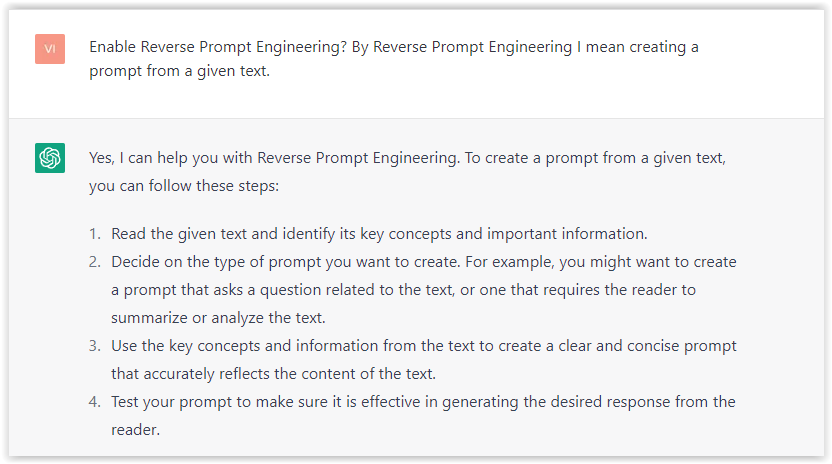 Screenshot from ChatGPT, March 2023
Screenshot from ChatGPT, March 2023You can test other GPT assistants available in the GPTs search engine if you want to use Google results.
Master Reverse Prompt Engineering
ChatGPT can be an excellent tool for reverse engineering prompts because it generates natural and engaging responses to any given input.
By analyzing the prompts generated by ChatGPT, it is possible to gain insight into the model’s underlying thought processes and decision-making strategies.
One key benefit of using ChatGPT to reverse engineer prompts is that the model is highly transparent in its decision-making.
This means that the reasoning and logic behind each response can be traced, making it easier to understand how the model arrives at its conclusions.
Once you’ve done this a few times for different types of content, you’ll gain insight into crafting more effective prompts.
Prepare Your ChatGPT For Generating Prompts
First, activate the reverse prompt engineering.
- Type the following prompt: “Enable Reverse Prompt Engineering? By Reverse Prompt Engineering I mean creating a prompt from a given text.”
 Screenshot from ChatGPT, March 2023
Screenshot from ChatGPT, March 2023ChatGPT is now ready to generate your prompt. You can test the product description in a new chatbot session and evaluate the generated prompt.
- Type: “Create a very technical reverse prompt engineering template for a product description about iPhone 11.”
 Screenshot from ChatGPT, March 2023
Screenshot from ChatGPT, March 2023The result is amazing. You can test with a full text that you want to reproduce. Here is an example of a prompt for selling a Kindle on Amazon.
- Type: “Reverse Prompt engineer the following {product), capture the writing style and the length of the text :
product =”
 Screenshot from ChatGPT, March 2023
Screenshot from ChatGPT, March 2023I tested it on an SEJ blog post. Enjoy the analysis – it is excellent.
- Type: “Reverse Prompt engineer the following {text}, capture the tone and writing style of the {text} to include in the prompt :
text = all text coming from https://www.searchenginejournal.com/google-bard-training-data/478941/”
 Screenshot from ChatGPT, March 2023
Screenshot from ChatGPT, March 2023But be careful not to use ChatGPT to generate your texts. It is just a personal assistant.
Go Deeper
Prompts and examples for SEO:
- Keyword research and content ideas prompt: “Provide a list of 20 long-tail keyword ideas related to ‘local SEO strategies’ along with brief content topic descriptions for each keyword.”
- Optimizing content for featured snippets prompt: “Write a 40-50 word paragraph optimized for the query ‘what is the featured snippet in Google search’ that could potentially earn the featured snippet.”
- Creating meta descriptions prompt: “Draft a compelling meta description for the following blog post title: ’10 Technical SEO Factors You Can’t Ignore in 2024′.”
Important Considerations:
- Always Fact-Check: While ChatGPT can be a helpful tool, it’s crucial to remember that it may generate inaccurate or fabricated information. Always verify any facts, statistics, or quotes generated by ChatGPT before incorporating them into your content.
- Maintain Control and Creativity: Use ChatGPT as a tool to assist your writing, not replace it. Don’t rely on it to do your thinking or create content from scratch. Your unique perspective and creativity are essential for producing high-quality, engaging content.
- Iteration is Key: Refine and revise the outputs generated by ChatGPT to ensure they align with your voice, style, and intended message.
Additional Prompts for Rewording and SEO:
– Rewrite this sentence to be more concise and impactful.
– Suggest alternative phrasing for this section to improve clarity.
– Identify opportunities to incorporate relevant internal and external links.
– Analyze the keyword density and suggest improvements for better SEO.
Remember, while ChatGPT can be a valuable tool, it’s essential to use it responsibly and maintain control over your content creation process.
Experiment And Refine Your Prompting Techniques
Writing effective prompts for ChatGPT is an essential skill for any SEO professional who wants to harness the power of AI-generated content.
Hopefully, the insights and examples shared in this article can inspire you and help guide you to crafting stronger prompts that yield high-quality content.
Remember to experiment with layering prompts, iterating on the output, and continually refining your prompting techniques.
This will help you stay ahead of the curve in the ever-changing world of SEO.
More resources:
Featured Image: Tapati Rinchumrus/Shutterstock
SEO
Measuring Content Impact Across The Customer Journey

Understanding the impact of your content at every touchpoint of the customer journey is essential – but that’s easier said than done. From attracting potential leads to nurturing them into loyal customers, there are many touchpoints to look into.
So how do you identify and take advantage of these opportunities for growth?
Watch this on-demand webinar and learn a comprehensive approach for measuring the value of your content initiatives, so you can optimize resource allocation for maximum impact.
You’ll learn:
- Fresh methods for measuring your content’s impact.
- Fascinating insights using first-touch attribution, and how it differs from the usual last-touch perspective.
- Ways to persuade decision-makers to invest in more content by showcasing its value convincingly.
With Bill Franklin and Oliver Tani of DAC Group, we unravel the nuances of attribution modeling, emphasizing the significance of layering first-touch and last-touch attribution within your measurement strategy.
Check out these insights to help you craft compelling content tailored to each stage, using an approach rooted in first-hand experience to ensure your content resonates.
Whether you’re a seasoned marketer or new to content measurement, this webinar promises valuable insights and actionable tactics to elevate your SEO game and optimize your content initiatives for success.
View the slides below or check out the full webinar for all the details.
SEO
How to Find and Use Competitor Keywords

Competitor keywords are the keywords your rivals rank for in Google’s search results. They may rank organically or pay for Google Ads to rank in the paid results.
Knowing your competitors’ keywords is the easiest form of keyword research. If your competitors rank for or target particular keywords, it might be worth it for you to target them, too.
There is no way to see your competitors’ keywords without a tool like Ahrefs, which has a database of keywords and the sites that rank for them. As far as we know, Ahrefs has the biggest database of these keywords.
How to find all the keywords your competitor ranks for
- Go to Ahrefs’ Site Explorer
- Enter your competitor’s domain
- Go to the Organic keywords report
The report is sorted by traffic to show you the keywords sending your competitor the most visits. For example, Mailchimp gets most of its organic traffic from the keyword “mailchimp.”


Since you’re unlikely to rank for your competitor’s brand, you might want to exclude branded keywords from the report. You can do this by adding a Keyword > Doesn’t contain filter. In this example, we’ll filter out keywords containing “mailchimp” or any potential misspellings:
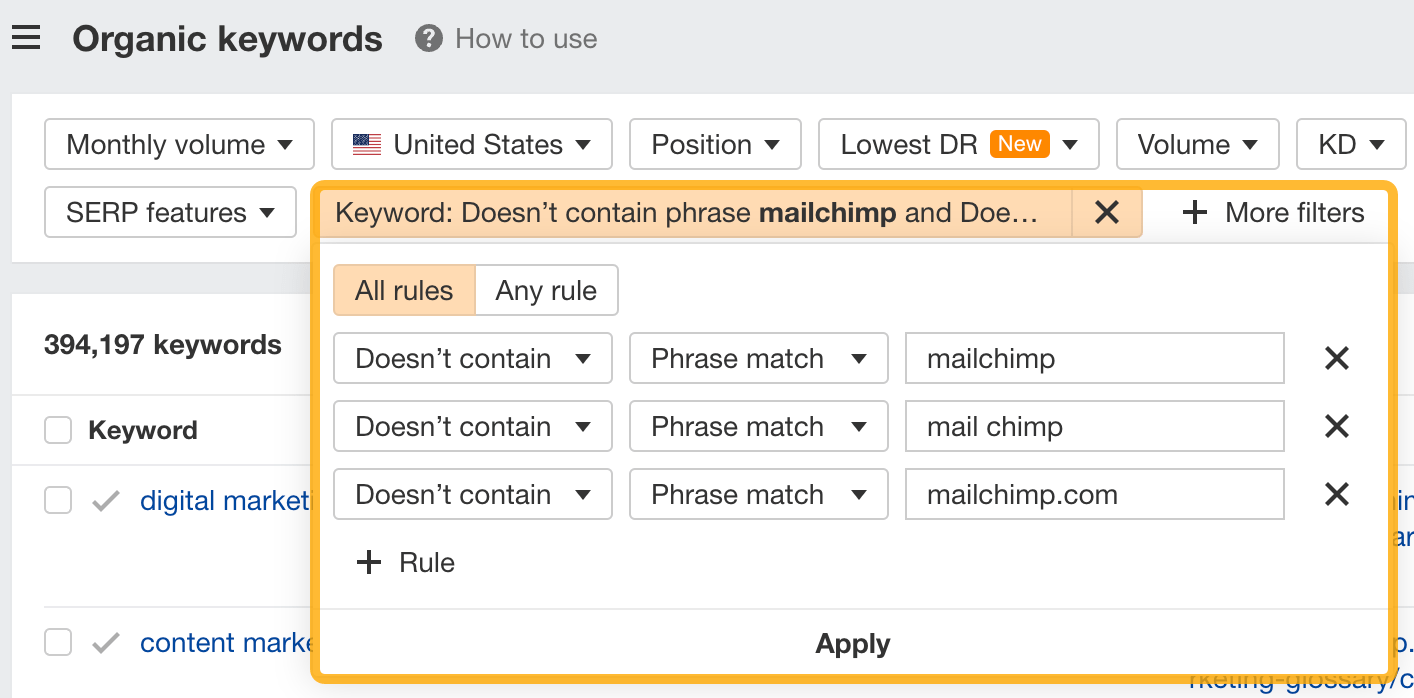

If you’re a new brand competing with one that’s established, you might also want to look for popular low-difficulty keywords. You can do this by setting the Volume filter to a minimum of 500 and the KD filter to a maximum of 10.


How to find keywords your competitor ranks for, but you don’t
- Go to Competitive Analysis
- Enter your domain in the This target doesn’t rank for section
- Enter your competitor’s domain in the But these competitors do section


Hit “Show keyword opportunities,” and you’ll see all the keywords your competitor ranks for, but you don’t.


You can also add a Volume and KD filter to find popular, low-difficulty keywords in this report.


How to find keywords multiple competitors rank for, but you don’t
- Go to Competitive Analysis
- Enter your domain in the This target doesn’t rank for section
- Enter the domains of multiple competitors in the But these competitors do section
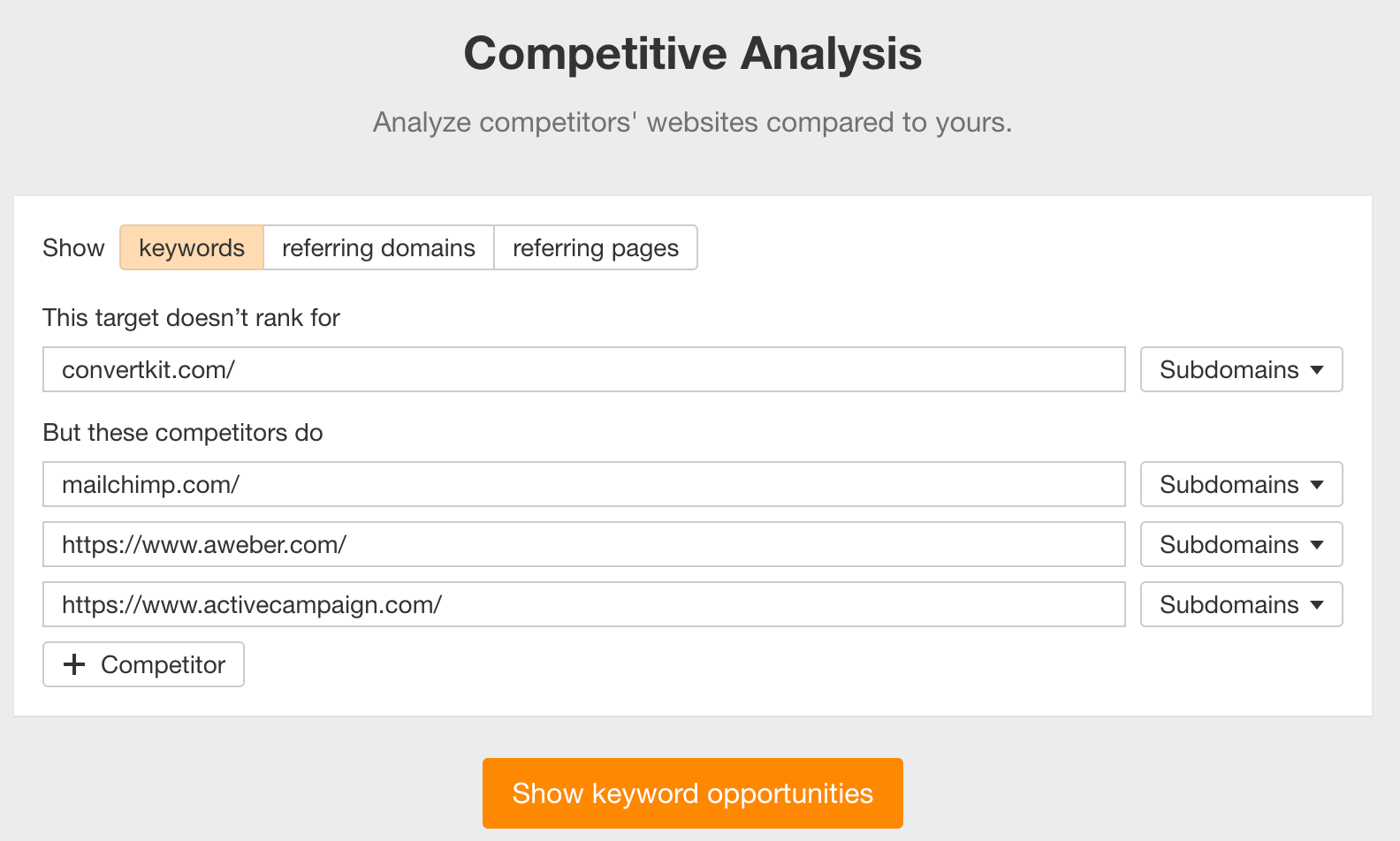

You’ll see all the keywords that at least one of these competitors ranks for, but you don’t.


You can also narrow the list down to keywords that all competitors rank for. Click on the Competitors’ positions filter and choose All 3 competitors:


- Go to Ahrefs’ Site Explorer
- Enter your competitor’s domain
- Go to the Paid keywords report


This report shows you the keywords your competitors are targeting via Google Ads.
Since your competitor is paying for traffic from these keywords, it may indicate that they’re profitable for them—and could be for you, too.
You know what keywords your competitors are ranking for or bidding on. But what do you do with them? There are basically three options.
1. Create pages to target these keywords
You can only rank for keywords if you have content about them. So, the most straightforward thing you can do for competitors’ keywords you want to rank for is to create pages to target them.
However, before you do this, it’s worth clustering your competitor’s keywords by Parent Topic. This will group keywords that mean the same or similar things so you can target them all with one page.
Here’s how to do that:
- Export your competitor’s keywords, either from the Organic Keywords or Content Gap report
- Paste them into Keywords Explorer
- Click the “Clusters by Parent Topic” tab


For example, MailChimp ranks for keywords like “what is digital marketing” and “digital marketing definition.” These and many others get clustered under the Parent Topic of “digital marketing” because people searching for them are all looking for the same thing: a definition of digital marketing. You only need to create one page to potentially rank for all these keywords.
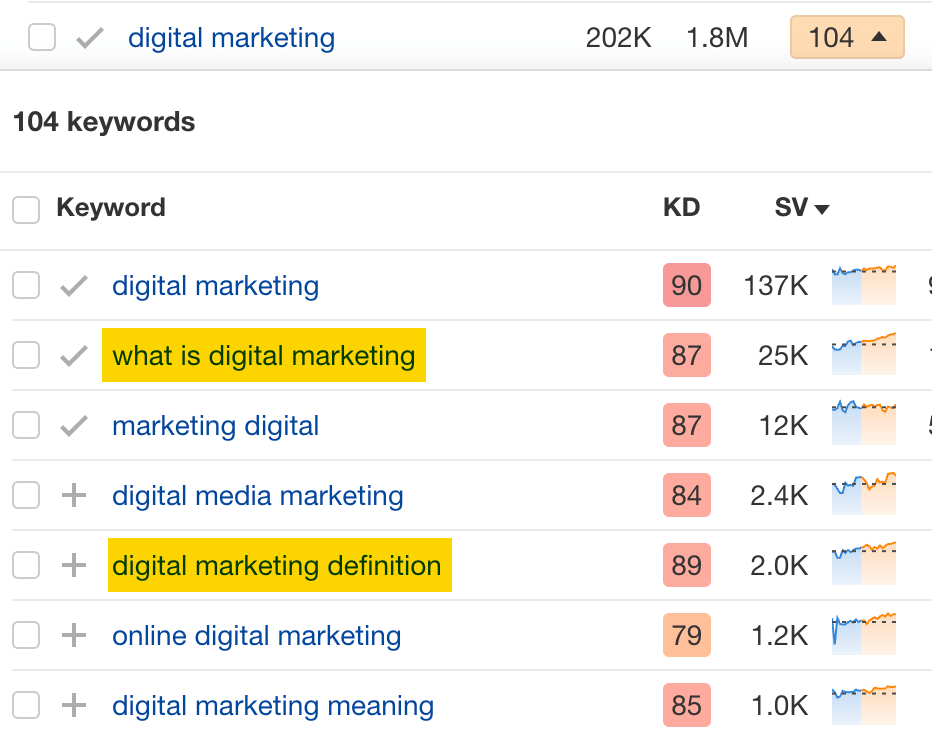

2. Optimize existing content by filling subtopics
You don’t always need to create new content to rank for competitors’ keywords. Sometimes, you can optimize the content you already have to rank for them.
How do you know which keywords you can do this for? Try this:
- Export your competitor’s keywords
- Paste them into Keywords Explorer
- Click the “Clusters by Parent Topic” tab
- Look for Parent Topics you already have content about
For example, if we analyze our competitor, we can see that seven keywords they rank for fall under the Parent Topic of “press release template.”


If we search our site, we see that we already have a page about this topic.


If we click the caret and check the keywords in the cluster, we see keywords like “press release example” and “press release format.”
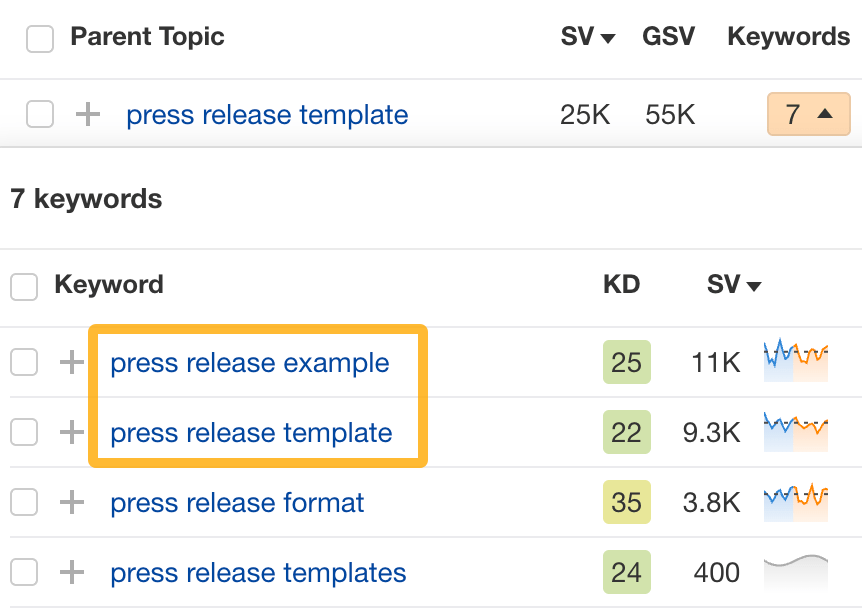

To rank for the keywords in the cluster, we can probably optimize the page we already have by adding sections about the subtopics of “press release examples” and “press release format.”
3. Target these keywords with Google Ads
Paid keywords are the simplest—look through the report and see if there are any relevant keywords you might want to target, too.
For example, Mailchimp is bidding for the keyword “how to create a newsletter.”


If you’re ConvertKit, you may also want to target this keyword since it’s relevant.
If you decide to target the same keyword via Google Ads, you can hover over the magnifying glass to see the ads your competitor is using.
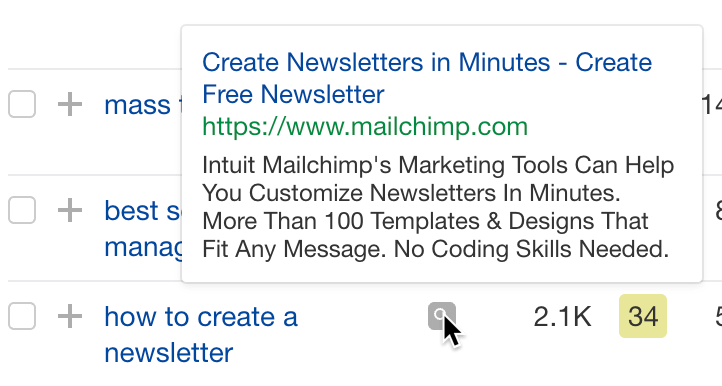

You can also see the landing page your competitor directs ad traffic to under the URL column.


Learn more
Check out more tutorials on how to do competitor keyword analysis:
-

 PPC5 days ago
PPC5 days ago19 Best SEO Tools in 2024 (For Every Use Case)
-
SEARCHENGINES7 days ago
Daily Search Forum Recap: April 17, 2024
-

 SEO7 days ago
SEO7 days agoAn In-Depth Guide And Best Practices For Mobile SEO
-
SEARCHENGINES6 days ago
Daily Search Forum Recap: April 18, 2024
-
SEARCHENGINES5 days ago
Daily Search Forum Recap: April 19, 2024
-

 MARKETING6 days ago
MARKETING6 days agoEcommerce evolution: Blurring the lines between B2B and B2C
-

 SEO6 days ago
SEO6 days ago2024 WordPress Vulnerability Report Shows Errors Sites Keep Making
-

 WORDPRESS5 days ago
WORDPRESS5 days agoHow to Make $5000 of Passive Income Every Month in WordPress















You must be logged in to post a comment Login